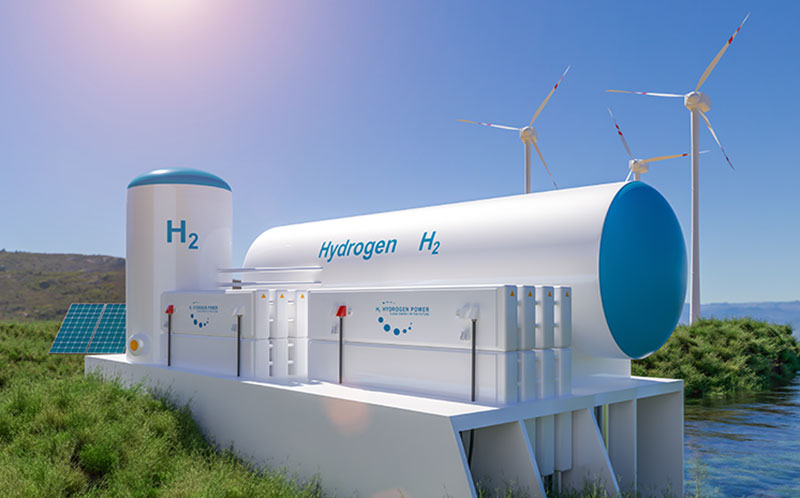Hydrogen:
The Champagne of the Energy Transition?
Fuel cell-powered automobiles are rare, and the production of the necessary hydrogen is complicated and costly. But it could transform and reshape future mobility, on land, on water and in the air. Opinions differ widely on fuel cells, with some seeing hydrogen as an endlessly available resource that can make zero-emission mobility a reality. Skeptics and critics consider hydrogen propulsion to be overrated and vastly overestimated and not ready for mass mobile operation. In the past two years, however, the political framework for the market introduction of hydrogen technologies has improved considerably, especially in Europe and Germany. In particular, the production of green hydrogen is the focus of many initiatives – such as the European Green Deal and the National Hydrogen Strategy in Germany, but also the pace of efforts in Asia – especially in China and Japan – continues to increase.
The National Hydrogen Strategy, however, is wide-ranging and, in addition to green hydrogen, also promotes other low-CO2 hydrogen production paths, use in transportation, industry and households, as well as transformation technologies such as fuel cells, gas turbines and engines. Plans for the required electrolysis plants are approaching the gigawatt range for the first time this year. Total fuel cell power sold this year will also exceed the 1 gigawatt limit for the first time, with the majority of this being in the transportation sector.
Energy transition with green hydrogen
Hydrogen is the fuel and energy carrier of the future – at least that is the opinion of the European Commission. In a report two years ago, it outlined that the EU’s path to a climate-neutral future would probably not be possible without hydrogen. It called hydrogen “the missing piece of the puzzle on the road to a fully decarbonized economy.” The energy carrier is expected to help decarbonize those sectors of the economy that cannot be directly electrified.
The element with the symbol “H” is the most abundant chemical element in the universe. It consists of only one proton and one electron. Nice and simple, but this odorless and colorless gas has it all. Each kilogram of hydrogen, or H2, contains about 2.4 times as much energy as natural gas. On Earth, much of the hydrogen is bound up in seas, oceans, lakes, and rivers. This is because hydrogen forms a compound with oxygen there – and thus becomes H2O, or water. In fact, hydrogen is a clean, versatile fuel that produces no direct greenhouse gas emissions – only oxygen is needed to release the energy, and the only byproduct is water.
To use hydrogen as an energy carrier, consumers need it as a gas. To do this, it must be “reversed” by combining with water. With the aid of electricity, the hydrogen can be separated from the oxygen – experts refer to this as “splitting”. The process used to achieve this is called electrolysis or “power-to-gas. If the electricity used in the process is “green” – i.e. comes from renewable energy sources – then the result is also “green”. Energy from the sun or wind can therefore be used to produce climate-neutral Green hydrogen.
It all comes down to production
H2 production methods, which range from clean to dirty, are divided into colors for clarity. The most common form of H2 used today (about 95 percent) is called gray hydrogen. Each ton of the gray variety produces about 10 tons of CO2 emissions because the production process – also known as “steam methane reforming,” or SMR – relies on gas or fossil fuels. Blue hydrogen, on the other hand, sounds much cleaner. But first looks are deceiving. It is actually gray hydrogen with CO2 emissions from the production process captured and stored underground (carbon capture and storage, CCS). However, supporters see this variant as a sustainable transitional technology until sufficient green hydrogen is available. Green hydrogen is the only useful alternative when it comes to sustainably reducing CO2 emissions. This is because green hydrogen is produced by electrolysis (splitting water into oxygen and hydrogen) using renewable energy.
Versatile applications
There are many areas of use where hydrogen could replace fossil fuels. Combined with a fuel cell, it can be used to power cars and trucks. If the gas is burned, it can be used to heat buildings and generate heat for industrial processes. Synthetic fuels for shipping and aviation can be produced from hydrogen and carbon dioxide. The chemical industry needs hydrogen to synthesize fertilizers, for example. And last but not least, hydrogen is suitable for storing renewable energies.
Hydrogen powered
Fuel Cells
for mobility
Hydrogen will establish itself as an energy carrier in certain vehicle segments, especially in the commercial vehicle sector. Automotive suppliers and OEMs are now working together, in some areas through extensive collaborations, primarily to develop fuel cell technology and related components. A study by the consulting firm FEV Consulting estimates that the use of fuel cells in passenger cars alone has a sales potential of eleven billion euros in Europe in 2040, and that some 70,000 jobs could be created. BMW is also sticking to fuel cells as an alternative to batteries and plans to launch a new generation of electric vehicles in 2025. Hydrogen could play a role in this, BMW CEO Zipse recently explained.
We communicate for your business
Have we caught your attention?
We are your experienced specialist and partner with long-standing expertise.
We support you in all fields of communication.





